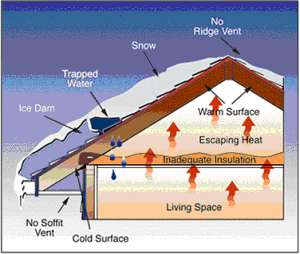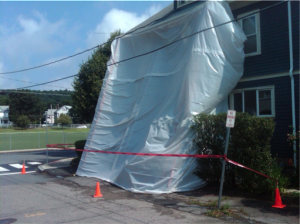[vc_row el_class=”redBorder”][vc_column width=”1/1″][vc_column_text]
Homeowner Alert!
The latest edition of the Massachusetts Building Codes contains some specific updates that your contractor may not be aware of! Here at Leighton Construction, LLC, we constantly keep ourselves informed of any updates that may affect your remodeling project. It’s just another way we deliver value for you and your home![/vc_column_text][/vc_column][/vc_row][vc_row bg_color=”#1e73be”][vc_column width=”1/1″][vc_tabs interval=”0″][vc_tab title=”Ice Dams” tab_id=”1394811932-1-75″][vc_column_text]
 Ice dams form when melted snow refreezes at roof edges. Anyone who has lived in cold climates has seen ice dams. We’ve enjoyed the sparkling beauty of ice formations built along roof eaves. However, most of us don’t stop to understand why these ice bands form until they damage our homes.
Ice dams form when melted snow refreezes at roof edges. Anyone who has lived in cold climates has seen ice dams. We’ve enjoyed the sparkling beauty of ice formations built along roof eaves. However, most of us don’t stop to understand why these ice bands form until they damage our homes.
Three things are required for an ice dam to form: snow, heat to melt the snow and cold to refreeze the melted snow into solid ice. Ice dams can form when as little as 1 or 2 inches of snow accumulates on a roof – if the roof is poorly insulated and air sealed, and the snowfall is followed by several days of sub-freezing temperatures. Ice dams develop as snow on the upper part of the roof melts. Water runs down the roof slope under the blanket of snow and refreezes into a band of ice at the roof’s edge creating a “dam”. Additional snow-melt pools against the dam and eventually leaks into the building through the roof or roof trim.
The reason ice-dams form along the roof’s lower edge, usually above the overhang, is straight-forward. The upper roof surface (toward the ridgeline) is at a temperature that is above freezing. And the lower part of the roof surface (along the eaves) is below freezing. The upper roof surface is located directly above the living space. Heat lost from the house warms this section of the roof, melting snow in this area. During periods of sub-freezing temperature the lower regions of the roof deck remain at sub-freezing ambient temperatures. Roof overhangs are not warmed by indoor heat-loss.
[/vc_column_text][/vc_tab][vc_tab title=”Lead Paint” tab_id=”1394811932-2-5″][vc_column_text]
 int
intIf your home was built before 1978, there’s a chance you have lead paint somewhere inside or outside your house. Don’t panic, we’re here to help.The supervisors and foremen here at Leighton are all Lead-Safe Certified Remodelers, and the company itself is registered with the state to safely remove any lead-based paint during a remodel project. We take your safety seriously.
This picture shows us replacing a front entryway on a home in Belmont that was built in the 1950’s. We tested the paint with an EPA-approved test kit and it came back positive.Don’t panic! We told the homeowners, we got this! We wrapped the front of the house, donned our protective masks, completed the work, and safely removed the waste to an approved facility. The front door got replaced, the remodel job went on, and not a single flake of paint was lost…
 For further reading, please visit these government web sites
For further reading, please visit these government web sites
US Department of Housing and Urban Development
US Environmental Protection Agency
[/vc_column_text][/vc_tab][/vc_tabs][/vc_column][/vc_row][vc_row][vc_column width=”1/1″][/vc_column][/vc_row]